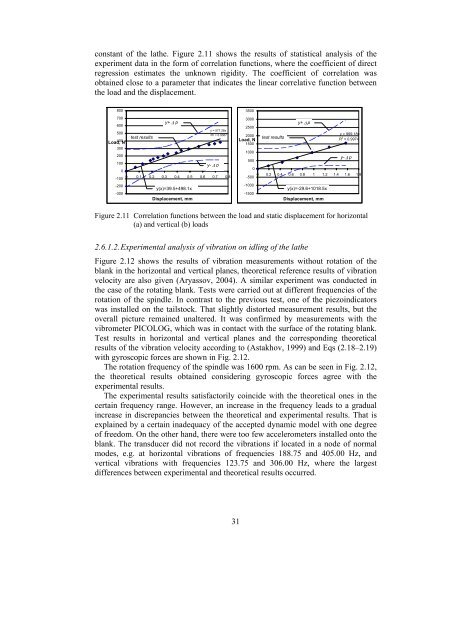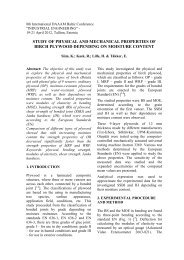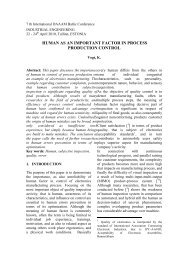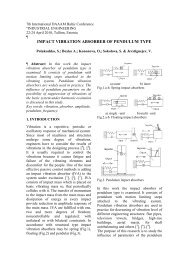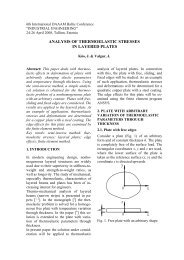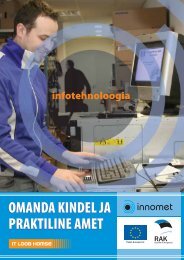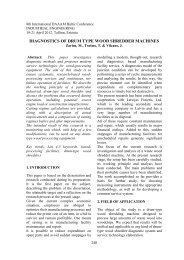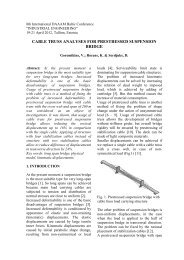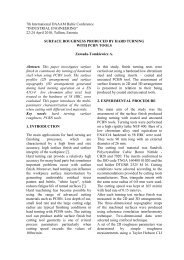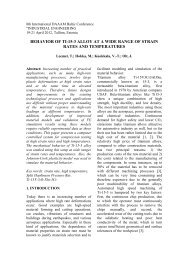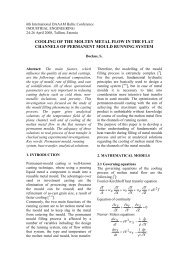Overview in PDF format - Tallinna Tehnikaülikool
Overview in PDF format - Tallinna Tehnikaülikool
Overview in PDF format - Tallinna Tehnikaülikool
You also want an ePaper? Increase the reach of your titles
YUMPU automatically turns print PDFs into web optimized ePapers that Google loves.
constant of the lathe. Figure 2.11 shows the results of statistical analysis of theexperiment data <strong>in</strong> the form of correlation functions, where the coefficient of directregression estimates the unknown rigidity. The coefficient of correlation wasobta<strong>in</strong>ed close to a parameter that <strong>in</strong>dicates the l<strong>in</strong>ear correlative function betweenthe load and the displacement.800700y+ ∆ p600y = 577.28x500Rtest results2 = 0.9367Load,400N300200100y- ∆ p0-1000 0.1 0.2 0.3 0.4 0.5 0.6 0.7 0.8-200y(x)=39.5+498.1x-300Displacement, mm3500300025002000Load, N150010005000-1000-1500test resultsy+ ∆ py = 999.18xR 2 = 0.99740 0.2 0.4 0.6 0.8 1 1.2 1.4 1.6 1.8-500y(x)=-29.6+1018.5xDisplacement, mmy- ∆ pFigure 2.11 Correlation functions between the load and static displacement for horizontal(a) and vertical (b) loads2.6.1.2. Experimental analysis of vibration on idl<strong>in</strong>g of the latheFigure 2.12 shows the results of vibration measurements without rotation of theblank <strong>in</strong> the horizontal and vertical planes, theoretical reference results of vibrationvelocity are also given (Aryassov, 2004). A similar experiment was conducted <strong>in</strong>the case of the rotat<strong>in</strong>g blank. Tests were carried out at different frequencies of therotation of the sp<strong>in</strong>dle. In contrast to the previous test, one of the piezo<strong>in</strong>dicatorswas <strong>in</strong>stalled on the tailstock. That slightly distorted measurement results, but theoverall picture rema<strong>in</strong>ed unaltered. It was confirmed by measurements with thevibrometer PICOLOG, which was <strong>in</strong> contact with the surface of the rotat<strong>in</strong>g blank.Test results <strong>in</strong> horizontal and vertical planes and the correspond<strong>in</strong>g theoreticalresults of the vibration velocity accord<strong>in</strong>g to (Astakhov, 1999) and Eqs (2.18–2.19)with gyroscopic forces are shown <strong>in</strong> Fig. 2.12.The rotation frequency of the sp<strong>in</strong>dle was 1600 rpm. As can be seen <strong>in</strong> Fig. 2.12,the theoretical results obta<strong>in</strong>ed consider<strong>in</strong>g gyroscopic forces agree with theexperimental results.The experimental results satisfactorily co<strong>in</strong>cide with the theoretical ones <strong>in</strong> thecerta<strong>in</strong> frequency range. However, an <strong>in</strong>crease <strong>in</strong> the frequency leads to a gradual<strong>in</strong>crease <strong>in</strong> discrepancies between the theoretical and experimental results. That isexpla<strong>in</strong>ed by a certa<strong>in</strong> <strong>in</strong>adequacy of the accepted dynamic model with one degreeof freedom. On the other hand, there were too few accelerometers <strong>in</strong>stalled onto theblank. The transducer did not record the vibrations if located <strong>in</strong> a node of normalmodes, e.g. at horizontal vibrations of frequencies 188.75 and 405.00 Hz, andvertical vibrations with frequencies 123.75 and 306.00 Hz, where the largestdifferences between experimental and theoretical results occurred.31


